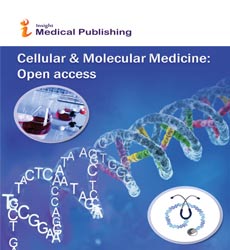Noninvasive Detection of Metabolic Alterations through In Vivo Magnetic Resonance Spectroscopy: A New Technology in Current Molecular Medicine
Jong-Hee Hwangn
DOI10.21767/2573-5365.100004
Jong-Hee Hwangn*
Lee Gil Ya Cancer and Diabetes Research Institute, Gachon University, Incheon- 406-840, South Korea
- *Corresponding Author:
- Jong-Hee Hwangn
Lee Gil Ya Cancer and Diabetes Research Institute, Gachon University, Incheon- 406-840, South Korea
Tel: + 82-32-899-6240
Fax: +82-32-899-6219
E-mail: jonghhwang@gachon.ac.kr
Received date: October 10, 2015; Accepted date: October 28, 2015; Published date: November 02, 2015
Abstract
As the prevalence of obesity explosively increases worldwide, the rise in the population with metabolic diseases is of great concern. Metabolic alterations can be assessed by typical medical techniques (e.g. tissue biopsy, etc.), however, noninvasive in vivo detection in living tissue was not forthcoming. Magnetic resonance spectroscopy (MRS), which is similar to magnetic resonance imaging (MRI) first appeared in medicine in 1970’s, can detect metabolic changes in vivo noninvasively.
Opinion
As the prevalence of obesity explosively increases worldwide, the rise in the population with metabolic diseases is of great concern. Metabolic alterations can be assessed by typical medical techniques (e.g. tissue biopsy, etc.), however, noninvasive in vivo detection in living tissue was not forthcoming. Magnetic resonance spectroscopy (MRS), which is similar to magnetic resonance imaging (MRI) first appeared in medicine in 1970’s, can detect metabolic changes in vivo noninvasively [1].
MRS functions without ionizing radiation by detecting stable isotopes (1H, 31P, 13C and others), in contrast to other imaging modalities, such as X-ray computed tomography (CT) or position emission tomography (PET). With its noninvasive nature, 1H, 13C and 31P MRS are actively utilized in clinical and preclinical studies. Quantification of lipids and important metabolites in living tissue are the forte of this technique. The data obtained by MRS offer a critical piece of metabolic information in animals and humans, and often serve as a very useful biomarker. For example, 1H MRS can quantify lipid content in liver and other metabolites in the brain and body, such as 2-hydroxyglutarate (2-HG), in vivo. A recent report indicated that the levels of 2-HG in tumors quantified by 1H MRS can be utilized as a biomarker to differentiate wild-type from mutated isocitrate dehydrogenase (IDH1 and IDH2) gliomas [2]. Of interest, the mutations in IDH1 and IDH2 were recently found to be most among human World Health Organization (WHO) grade 2 and 3 gliomas. Thus this new technique, 1H MRS opens up a new way to aid the clinical management of patients with gliomas, particularly for follow-ups after treatment.
Furthermore, many studies have indicated that hepatic and intramyocellular lipid content quantified by 1H MRS is correlated with insulin resistance. Thus noninvasively measured lipid content can be utilized as a biomarker for insulin resistance, which is the best predictor for the clinical onset of type 2 diabetes. In addition, highly sensitive and specific 1H MRS technique can help accurately evaluate the efficacy of a new drug in clinical trials for quantifying the content of liver fat without tissue biopsy. This accurate method also can aid to expedite the drug development process by providing robust and statistically significant data from a modest pool size of patients [3]. Therefore this can be a good way to effectively cut cost in both preclinical studies and clinical trials.
Furthermore, employing other stable isotopes, such as 13C MRS, hepatic glycogen synthesis and breakdown can be directly detected in real time, and altered glycogen metabolism was detected in type 1 and type 2 diabetes mellitus. In addition, 31P MRS can provide in vivo ATP synthesis rates and/or in vivo ATP content in living tissue [1].
This technique provides not only comfort to patients, but also a unique means to detect metabolites in vivo, including intermediates, which can be easily oxidized or reduced in ambient air (e.g., in vivo ATP content). Though the high cost of MRI equipment can be a potential limitation, this cutting-edge MRS technology can deliver a new avenue to noninvasively study molecular and cellular medicine in vivo.
References
- Hwang JH, Choi CS (2015) Use of in vivo magnetic resonance spectroscopy for studying metabolic diseases. Exp Mol Med 47: e139.
- Choi C, Ganji S K, DeBerardinis RJ, Hatanpaa KJ, Rakheja D, et al. (2012) 2-hydroxyglutarate detection by magnetic resonance spectroscopy in IDH-mutated patients with gliomas. Nat Med 18: 624-629.
- Stefan N, Ramsauer M, Jordan P, Nowotny B, Kantartzis K, et al. (2014) Inhibition of 11beta-HSD1 with RO5093151 for non-alcoholic fatty liver disease: a multicentre, randomised, double-blind, placebo-controlled trial. Lancet Diabetes Endocrinol 2: 406-416.
Open Access Journals
- Aquaculture & Veterinary Science
- Chemistry & Chemical Sciences
- Clinical Sciences
- Engineering
- General Science
- Genetics & Molecular Biology
- Health Care & Nursing
- Immunology & Microbiology
- Materials Science
- Mathematics & Physics
- Medical Sciences
- Neurology & Psychiatry
- Oncology & Cancer Science
- Pharmaceutical Sciences
